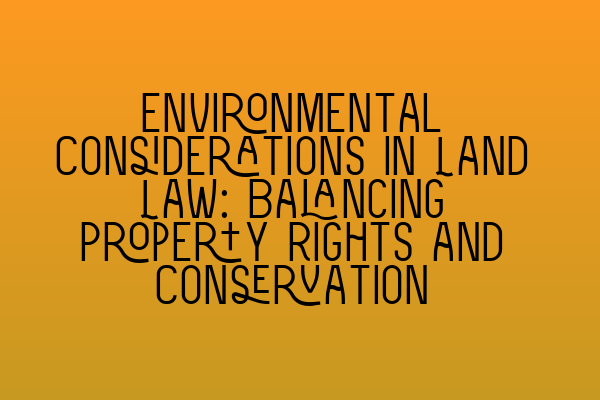Environmental Considerations in Land Law: Balancing Property Rights and Conservation
Introduction: The Significance of Environmental Considerations in Land Law
In recent years, the importance of environmental considerations in land law has become increasingly significant. As society becomes more aware of the threats posed by climate change and the need to protect the natural environment, the legal framework surrounding land ownership and use must evolve accordingly. This blog post will explore the delicate balance between property rights and conservation, highlighting the key considerations and legal principles involved.
Ensuring Sustainable Land Use: A Key Priority
One of the primary objectives of environmental considerations in land law is to promote sustainable land use. This means that landowners and developers must take into account the long-term environmental impact of their actions. Sustainable land use involves striking a balance between economic development and the preservation of natural resources for future generations.
For instance, when considering the construction of new buildings or infrastructure projects, it is essential to assess the potential impact on the local ecosystem, such as the disruption of wildlife habitats or the depletion of water resources. Moreover, sustainable land use also requires the implementation of measures to mitigate environmental harm, such as waste management strategies and carbon offsetting initiatives.
Legal Mechanisms to Protect the Environment: A Closer Look
To ensure that environmental considerations are taken into account, various legal mechanisms have been established. These mechanisms aim to regulate land use activities and provide avenues for the protection and preservation of the environment.
Some of the key legal mechanisms include:
1. Environmental Impact Assessment (EIA): This process involves the evaluation of the potential environmental effects of a proposed development project. It requires developers to assess and mitigate any adverse effects on the environment before obtaining planning permission. The EIA process ensures that environmental considerations are integrated into development decision-making.
2. Conservation Designations: Conservation designations, such as Sites of Special Scientific Interest (SSSIs) and National Parks, confer legal protection on areas with significant ecological or cultural value. These designations restrict certain activities and development within designated areas to preserve their unique features.
3. Planning Policy: Planning policies set out guidelines and criteria that local authorities use to make decisions about land use and development. These policies often include environmental considerations, such as requirements for green spaces, sustainable design, and the protection of wildlife habitats.
Balancing Property Rights and Conservation: Challenges and Solutions
Achieving a balance between property rights and conservation is a complex task. Property owners have certain legal rights over their land, including the right to use and develop it. However, these rights must be exercised in a manner that does not unduly harm the environment.
To address this challenge, the law has put in place a range of measures to reconcile property rights with environmental considerations. These measures include:
1. Compensation Mechanisms: In certain cases where landowners are impacted by environmental regulations, compensation mechanisms may be in place to provide fair compensation for the economic loss suffered as a result. This helps to strike a balance between protecting the environment and respecting property rights.
2. Sustainable Development: The concept of sustainable development encourages landowners and developers to consider the long-term environmental implications of their actions. By incorporating sustainable practices into land use and development, property owners can help to minimize their impact on the environment while still enjoying their property rights.
Conclusion: The Way Forward
Environmental considerations in land law play a crucial role in balancing property rights with conservation. As society becomes increasingly conscious of the need to protect the environment, it is essential for the legal framework to adapt accordingly. By promoting sustainable land use, implementing effective legal mechanisms, and finding solutions that strike a balance between property rights and conservation, we can create a future where both the natural environment and property rights are respected and preserved.
Related Articles:
– Updates in UK Property Laws: Key Changes and Implications
– Legal challenges in property transactions: A comprehensive guide
– Navigating Lease Laws in the UK: Essential Guidelines for Tenants and Landlords
– Dominate Property Law Questions: Avoiding Common Pitfalls
– Land Law Revision Tips: Ace Your Exam Preparation
